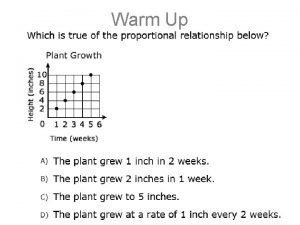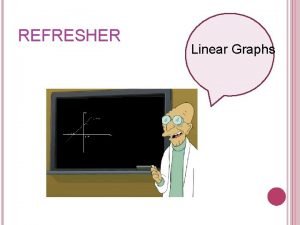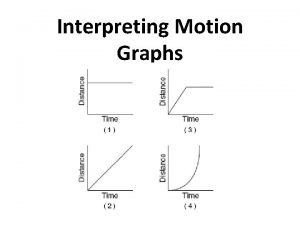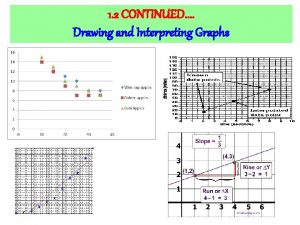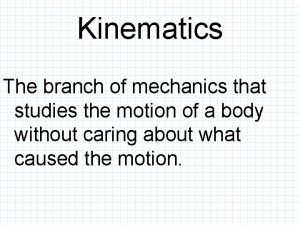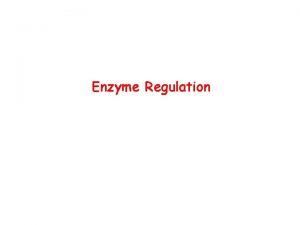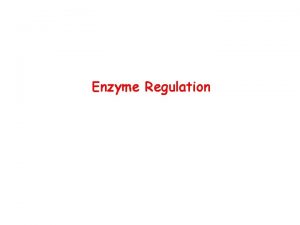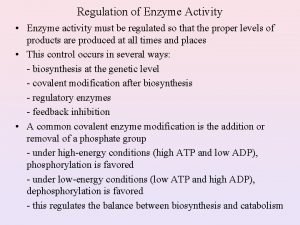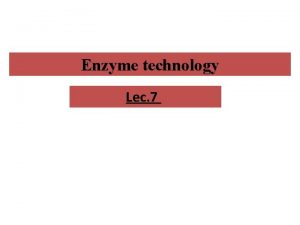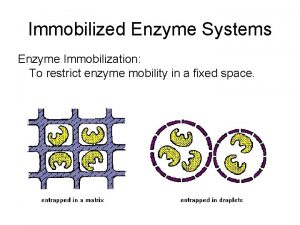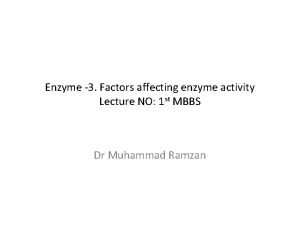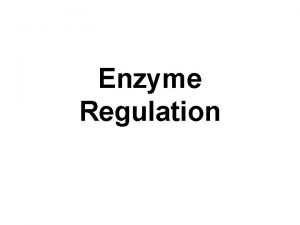Enzyme Station Activity INTERPRETING DATA GRAPHS Station 1
















- Slides: 16

Enzyme Station Activity INTERPRETING DATA & GRAPHS

Station 1 1. The enzyme would most likely affect reactions involving A. B. C. D. molecule A, only molecule C, only molecules B and D molecules A and C 2. Which graph, A or B, shows the amount of substrate going to zero faster? 3. If both graphs A and B show the rate of an enzyme, which enzyme is more effective? (hint: think about which makes the product fastest)

Station 2 4. What variables affect enzyme activity in each of the graphs? A. B. C. _______________________________ 5. What is the optimal condition for each enzyme represented by the graphs? The optimal condition is when the enzyme would work best. A. B. _______________________________

Station 2 6. What happens when an enzyme gets too hot? 7. Explain why graph C levels off. Use enzyme and substrate in your explanation. Why doesn’t it matter if enzymes keep getting added?

Station 3 8. What is the optimal p. H for both enzymes? A. Pepsin _______ B. Trypsin_______ 9. Predict the reactivity of trypsin at p. H 14 A. B. C. It’s working optimally (best) The enzyme will be denatured(change shape) and not work The enzyme will work at a medium rate 10. At what p. H do neither enzyme work? 11. Which enzyme works best at p. H 3? 12. At what p. H values is pepsin likely to be denatured?

Station 4 Use the graph below to answer questions 13 -15. 13. At what temperature does this enzyme work optimally (best)? 14. What happens to the enzyme activity as the temperature decreases from 20 C to 10 C? 15. How can the enzyme activity be slowed down? A. B. C. Increase temperature from 10 C to 20 C Increase temperature from 20 C to 30 C Decrease the temperature from 30 C to 20 C

Station 5 16. Humans share several enzymes with thermophilic bacteria. A. What is the temperature that enzymes work optimally in humans? _______ B. What is the temperature that enzymes work optimally in thermophiles? _______ 17. At what temperature will the enzyme function for both human and thermophiles? A. 10 C B. 40 C C. 50 C

Station 6 Based on the graph above: 18. Which enzyme works best in neutral conditions? 19. Which enzyme is not affected by p. H? 20. Which enzyme works under basic conditions? 21. Which enzyme might be found in acidic stomach acid?

Station 7 The following graph shows data recorded on the effect of temperature on the functioning of salivary amylase. 21. What is an appropriate title for this graph? 22. What is the independent variable? 23. What is the dependent variable? 24. Based on these results, at what temperature does amylase react the fastest? 25. What do you think would happen if the temperature were raised above boiling (100 C)?

Station 8 The following graph shows data recorded on the effect of p. H on the functioning of salivary amylase. 26. Based on these results, what is the optimal (best) p. H for amylase? 27. Is this optimal p. H considered acidic, basic, or neutral? 28. Why does the activity decrease when the p. H is too low or too high?

Station 9 29. The substrate for a particular reaction is shown below. In the box labeled “Enzyme, ” predict the shape of the enzyme that will react with this substrate. Draw the enzyme that would work with that substrate. 30. Explain the significance of the shape of the enzyme that you just drew. 31. In the box below, predict the shape of the enzyme AFTER the reaction has taken place. . Draw it and explain your prediction. 32. In the box below, predict the shape of the enzyme AFTER the reaction has taken place. Draw it and explain your prediction.

Station 10 Application: 33. During an illness, like the flu, one may experience very high fevers. How might this affect the functioning of enzymes in the body and the length or time required for recovery? 34. The fur color of the adult northern seal, created by a dark brown pigment, is due to a specific enzyme. Suggest reasons why baby seals are born with a pure white coat.

Station 11— Honors Answer the questions based on the graphs.

Station 11—Honors Answer the questions based on the graphs in Part I. 35. What is the function of an enzyme? 36. What is happening to the substrate with enzyme function? 37. Describe the pattern of enzyme function shown by the data in the graphs. 38. At which p. H is the enzyme functioning best? Explain why. 39. If at one p. H the substrate is all converted to product in 5 seconds, and at another p. H it takes 7 seconds for all of the substrate to be converted, at which p. H is the enzyme functioning best? Why?

Station 12— Honors Answer the following questions based on the graphs. 40. Describe the pattern of enzyme function shown by the data in the graphs. 41. At which temperature is the enzyme functioning best? Explain why.

Extra Question Looking at graph B, as the enzyme concentration increases, the rate of reaction ______. Increases, decreases, stays the same)
 Enzyme activity graph
Enzyme activity graph Enzyme activity graph
Enzyme activity graph Making science graphs and interpreting data
Making science graphs and interpreting data Interpreting circle graphs
Interpreting circle graphs Interpreting distance time graphs
Interpreting distance time graphs Interpreting graphs of proportional relationships
Interpreting graphs of proportional relationships Interpreting graphs of functions algebra 1
Interpreting graphs of functions algebra 1 Interpreting linear graphs
Interpreting linear graphs Distant time graph
Distant time graph Describing visual data
Describing visual data Interpreting velocity time graphs
Interpreting velocity time graphs Drawing and interpreting graphs
Drawing and interpreting graphs Circle graph definition
Circle graph definition Interpreting line graphs year 5
Interpreting line graphs year 5 Interpreting distance time graphs
Interpreting distance time graphs Interpreting graphs
Interpreting graphs Creating and interpreting distance time graph
Creating and interpreting distance time graph





